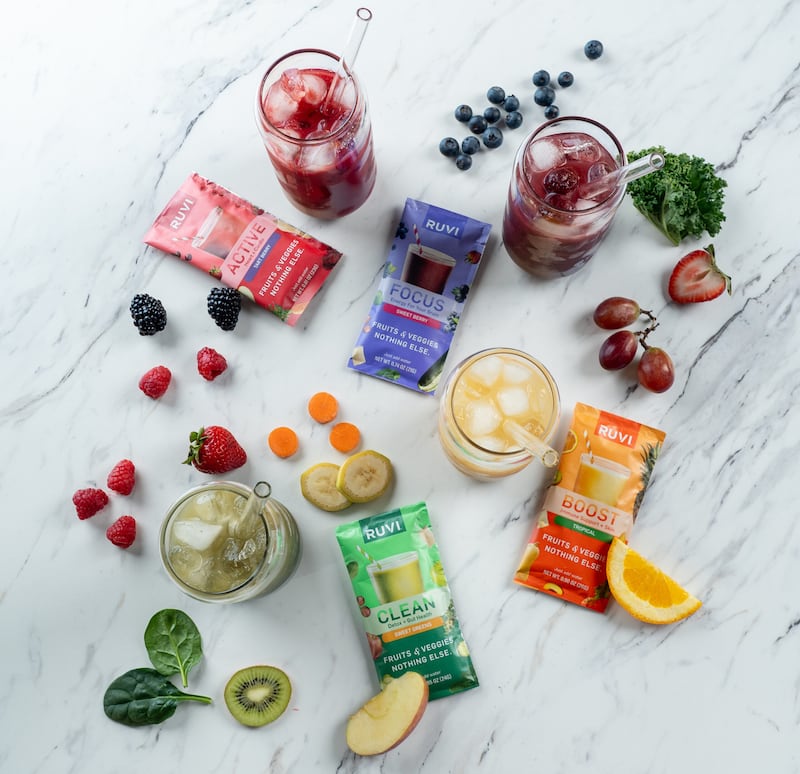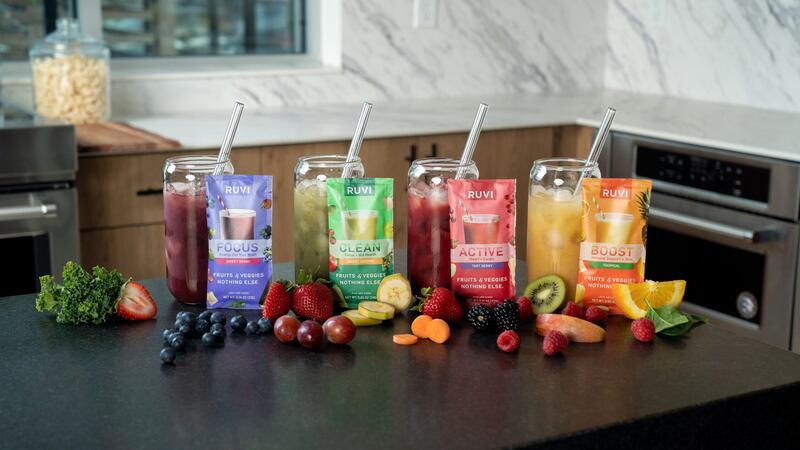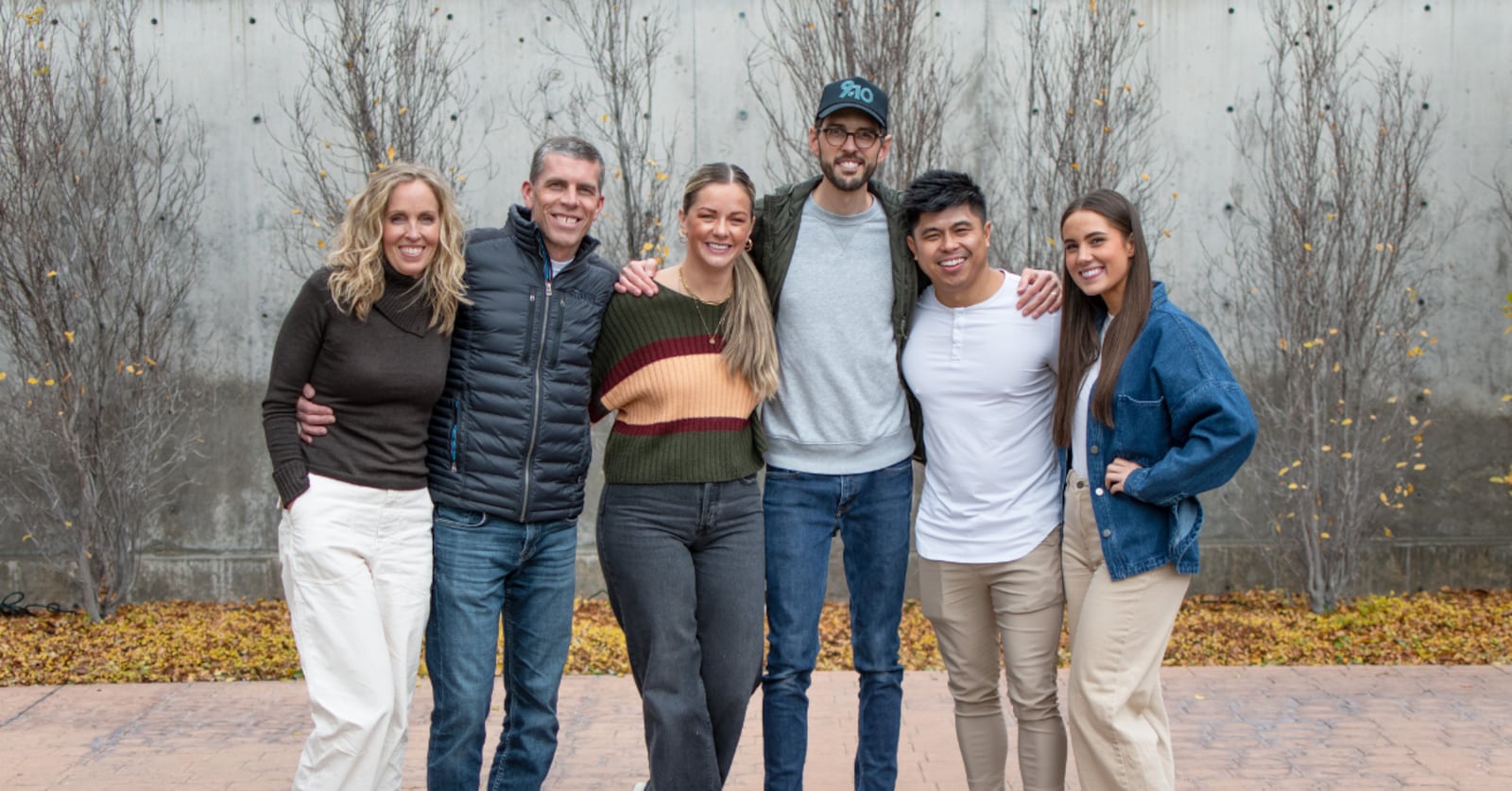The road to making a line of freeze-dried whole fruit and vegetable mixes wasn’t an expected one at first. A few years into it, however, it’s a journey that feels more natural to me every day. People are understanding that fruits and vegetables serve as medicine and that we should be consuming the nutrients our bodies need through what we eat, not by relying on supplements.
That’s why Ruvi was created in the first place: to make great nutrition easier to achieve.
From waste to wellness
A key discovery was made early on. When you finish freeze-drying spinach or strawberries, a powder is left behind. When my business partner Jason Budge saw it piling up inside our huge bus-sized dryers, we knew immediately we couldn’t throw it away: it’s nutritional gold!
At the time, I was deep into researching fruits and vegetables, learning how freeze-drying affects produce. My partner co-owns the largest freeze-dry manufacturing company in North America, Thrive Foods, and he’d brought me over to assist with product development.
Obviously, freeze-drying is a preservation method. It helps either store foods for long periods of time or allows you to take them with you without the need for refrigeration. But I was interested in the rich-in-nutrient powder that was being left behind.
One day, I was at my desk, snacking on a bag of fruits and vegetables. While eating, I was learning how much produce degrades after being harvested and how quickly nutrients deteriorate. I thought, “Am I eating the nutritional equivalent of cardboard?” The reverse of that is true about freeze-drying, however: nutrients are locked in. In fact, the nutritional content is higher in freeze-dried produce than in “fresh” grocery store produce.
My partner and I knew daily fruits and vegetables were important and that people weren’t consuming enough for a balanced diet. Only 1 in 10 people manage to consume an adequate amount. Since we had the freeze-drying technology already, we wondered what more we could do with it. Perhaps we might solve this deficiency problem, even making it a little easier for people to get the vitamins and minerals their bodies crave.
Nutritional gold
That idea led naturally to the next step: lots of brainstorming and experimenting. We pulled these powders into our production kitchen, which led to blending them together. The hope was to create several powdered “just add water” drink mixes.Prepping for a meeting one day, I quickly blended some blueberry, spinach and strawberry powders together, mostly to see what they’d taste like combined. When those in the meeting sampled it, they couldn’t believe nothing else had been added. No sugars, stevia or sweeteners—just straight-up fruits and vegetables. Right away, we knew we could create an amazing product that wouldn’t need additives, sweeteners or preservatives. It was a breakthrough for us. What we wanted to do was doable, and we knew it.

It was 2019, and we were becoming experts in freeze drying, learning the true power of produce. We were getting creative with solving a problem that much larger food companies didn’t appear to be interested in. There hasn’t been much innovation there—they’ve cut up fruit and put it into sugary syrup or made salads and put them in bags. That’s helped, but there hasn’t been a large push toward innovation and accessibility. We felt ready to tackle that problem.
Nutrition can combat long-term health complications like diabetes, high blood pressure and even Alzheimer’s. Many cases are preventable when you add the proper nutrients to your diet.
We know we need fruits and vegetables, but how could we make it more convenient? How could we enable people to get their nutrition more efficiently? Fruits and vegetables deteriorate quickly. They’re hard to prepare, and washing and shopping takes time. For many reasons, people don’t eat them. If we made it easier and more enjoyable, however, we could help people get the vitamins, minerals, antioxidants and fiber they needed. Our mission became to crush nutritional deficiency with the power of fruits and vegetables.
Startups are hard, but we’re passionate about helping people live healthier lives. And when you hear from customers about how your product has changed their lives in some way—helping them lose weight, giving them increased energy or improving their digestion—that propels us forward. It’s exactly why we do this and why we keep doing it.
The perfect blend
In Ruvi’s early days, we were within this arm of Jason’s other company, which was stable and had several brands within it. In some ways, they were like a brand development house that included Peak Refuel (a backpacking food brand), food storage brands and others. All had freeze-drying as their core element. Thrive was great at manufacturing and managing supply chain.
In short, we didn’t have to start from scratch. It wasn’t like Jason and I were hanging out in a coffee shop saying, “Can we rent a little space to start mixing some stuff up?”
Because Ruvi was initially one of Jason’s other brands, there was already a customer base in place. By selling to them first and finding out what they thought of it, it became an easy market testing opportunity. We knew we wanted to launch on our own at some point. Until then, we could learn with those we had a relationship with.The good news? When Ruvi started selling in Thrive, it immediately became a top-selling product. Some not-so-good news? COVID-19 hit weeks later. And because that brand also specialized in food storage, many customers pivoted quickly into food storage products. Because Ruvi has never been positioned as food storage—it’s an everyday product meant to provide you with your servings of fruits and vegetables—we got passed up.
It quickly became time to try another direction. We needed to find consumers interested in everyday nutrition, not products stored in the pantry for years. It meant escalating our desire to find a new customer base and to move operations and marketing into our own control. For our customers who have been with us from the beginning and always loved Ruvi, we love you and your support!
One of the downsides of launching into Jason’s parent company is that we were always the newest brand on the block. While other brands were more established and higher priority, we were always the last to get attention. It was a struggle. We’d gain all this momentum and then be out of stock. Momentum would build again, and we’d be out of stock again. Maintaining consistency in our growth pattern was both complex and frustrating.
By 2022, we’d officially pulled away. Ruvi products had been market testing in 2021, but 2022 was our official debut when we launched on our own two feet. We pulled the supply chain and manufacturing into our control and no longer relied on Thrive Foods to do those things for us.
Today, we have complete control. It’s much smoother for many reasons but it can still be hard. Freeze-dried powders are delicate and need to be handled in a specific way. As soon as you start to powder freeze-dried ingredients like fruits and vegetables, the water in the environment will begin to collect into that freeze-dried powder. It’s tricky to work with, and it has taken a couple of solid years to understand the best ways to handle the powders.
What we do at Ruvi is no manufacturing nightmare, but it takes persistence. Luckily, Jason had that expertise coming into this project. There have been learning curves. If somebody wants to start out of the gate and begin freeze-drying fruits and vegetables, just know it’s tough.
Utah is a perfect place to make our products, though, because it’s so dry here. If it’s a rainy day, we won’t even attempt to grind our powder. Too much moisture in the environment can ruin our output for a while. Fortunately, almost every day in Utah is 100 percent conducive to making Ruvi.
Remembering my roots
I reflect on my decisions and all that has brought me to my present. When I was young, I started valuing eating well for the good effects it had on my body. It started with my grandparents, Ruth and Nathan Hale, who have very recognizable names in this state for starting Hale Center Theatre.
Beyond creating a space where families could enjoy community theater, they also built a ranch house where we could gather in Grover, Utah, a true haven during my childhood. I spent my summers with Grandma Ruth; she had a massive garden we helped look after. Everybody had to weed their respective row before hunting for lizards.
More importantly, she taught me when she cooked from the garden every night. We’d often go into Capitol Reef National Park, where an old pioneer orchard filled with treasures is located. We were allowed to pick all the fruit we could stomach when it was in season, and picking apricots was typical. I brought back a box of apricots and ate so much that I made myself sick. I couldn’t eat an apricot for five years after that.
My mother loved her vegetable garden as well. In a very real way, I’ve been passed that baton. I carried what I learned from my childhood into who I am now. I get to share what I already know: these gifts from Mother Nature are actually power. Fruits and vegetables are power for your body. Once you understand that, it can help turn your life around and get you to a place where you feel vibrant, happy and healthy.
Food heals us. That’s my message.


